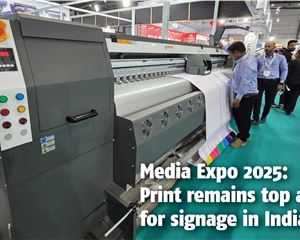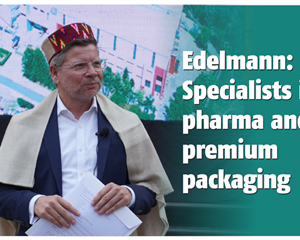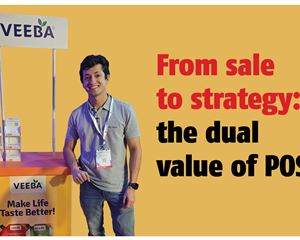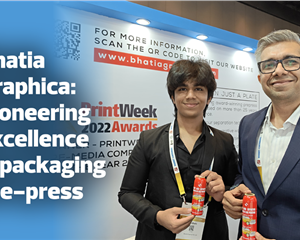Manroland Goss’s focus at Drupa was on packaging, including booklet printing
Team Manroland Goss at Drupa — Franz Kriechbaum, CEO; Wolfgang Hiesinger and SVP at Manroland Goss; and Sudeep Bhattacharjee, managing director at Manroland Goss India discuss the company’s presses, the segment it focuses on, and Indian print market with Noel D’Cunha
20 Aug 2024 | By Noel D'Cunha
Noel D’Cunha (NMD): How has Drupa been for Manroland Goss?
Franz Kriechbaum (FK): I’ve had a thrilling experience at Drupa. It was my first time at the event in eight years. We had visitors from nearly 70 countries, from Asia, Africa, Europe, and other continents. Our visitors had diverse professional backgrounds and levels of experience, including apprentices, interns, and students in the printing and packaging fields. It was a great experience interacting with such a wide range of visitors.
NMD: There are whispers that the visitor count is slightly lower (around 30% lower) than it was in 2016. You weren’t here in 2016, but do you think it has impacted your presence here?
FK: We have frequently heard that the overall number of visitors is lower. In our neighbourhood, there are very interesting and reputable brands such as Konig & Bauer, HP, RMGT, and others. I believe that we are in a location where many people are and where many people are interested in our innovations. So, I would say that we don’t see that 30% decrease. We had a good number of visitors, even though we don’t keep count, we are always busy. You could always see something happening.
NMD: So let’s delve into the technology. You did not bring the full machine? Wolfgang Hiesinger (WH): We brought one printing unit. And the problem with the Varioman is the name itself. It’s so variable, we built one.
FK: Our current setup allows us to print units and transition into leaflet production. We work with various materials such as shrink sleeves, plastic, and cardboard, and we have integrated a revolver into the production line. To enhance the visitor experience, we wanted to ensure that the equipment remains easily accessible for demonstration, even though we prefer to limit physical contact with the running machinery. As the CEO, I found it crucial to leave a lasting impression on visitors. Our printing machine allows for seamless image changes, and we encourage visitors to try it themselves. It’s essential for us to provide an immersive experience that allows people to see, feel, and interact with our products across the entire booth.
NMD: So, was your focus on packaging?
WH: We are primarily focused on packaging, including booklets. At Drupa, we brought artificial intelligence for newspapers, commercials, and packaging printing. Our camera system also covers everything from this perspective, not just packaging as a whole. Our existing customer base is familiar with our work, but we are eager to connect with more packaging printers. We’ve had a lot of success in meeting new potential partners recently.
NMD: What are the Indian visitors saying? Which machine on showcase here will be key for the Indian market?
Sudeep Bhattacharjee (SB): We have had quite a few Indian visitors. Apart from some pre-scheduled meetings, we had some big packaging groups walk in. I didn’t expect there to be so many walk-ins to see the Varioman press.
Legacy printers, like newspapers and commercial printers, showed a lot of interest in the AI-assisted maintenance platform, Maintellisense. Most of them were impressed, and some said that we might be ahead of the industry because this technology is used in the airline industry, not typically in a printing machine.
NMD: Can you tell us more about the Varioman and Maintellisense?
SB: For packaging, we have a new product, Varioman, marking the beginning of its lifecycle. We are exploring opportunities outside the realms of gravure and flexo. The Indian market is mainly dominated by gravure, so we need to consider ways to make operations more efficient, utilising technology and manpower optimally.
Maintellisense is particularly useful for legacy printing, where it’s not feasible to monitor thousands of data points every second. For example, Maintellisense can track breakdowns and provide insight into what happened to different areas of the press then. This was not possible before. This technology can help us understand the causes of issues like web breaks in the printing process and improve overall efficiency.
FK: I’d like to add that I spoke with a customer from India recently. One common issue is that the run length is getting shorter and shorter. Many printers are considering digital printing to be the right solution for very short-run printing. Many have also heard about offset, which could be an option. Additionally, an Indian gravure machine manufacturer sent one of their customers to us because they knew the customer was looking for something different. They are seeking technology that can reduce the cost of printing for shorter run lengths.
NMD: Are you saying that users of the gravure printing method are looking for an alternative?
WH: Yes. The Varioman comes in three models designed for different purposes. The F-Line is used for flexible packaging and can print on films/paper ranging from 10 microns to 300 microns. The C-Line is used for carton/rigid packaging and can print on paper/board ranging from 100 microns to 700 microns. The B-Line is used for book printing and can handle paper from 30gsm to 120-gsm.
NMD: Are you referring to offset printing? Currently in India, we’re observing that the gravure printing business is shifting towards CI flexo.
WH: Indeed, many people are considering CI flexo, and I agree. However, with CI flexo there are some compromises in printing quality, and there are still costs associated with creating print forms. Also, CI flexo isn’t ideal for short print runs. While it may be easier to use water-based inks and eliminate solvents, it still involves compromising print quality and is an expensive process for creating print forms.
NMD: It’s interesting how the landscape of print has evolved. Digital printing was originally seen as an alternative to offset for short-run jobs, but now you are saying that offset is considered an alternative to CI flexo for short-run jobs.
WH: The general flow for printing runs seems to be gravure for long runs, CI flexo for medium-length runs, and offset. As for very short-run lengths (around 3,000 sqm and below), digital printing is the best solution.
FK: A German book printing customer of Manroland Goss claimed that printing 400 copies of a book on the Lithoman is equivalent to using inkjet. This suggests that the customer has optimised low-run printing.
NMD: In India, most short-run packaging is being driven by start-up companies seeking to establish themselves.
SB: Today, many big packaging companies in India have a digital option, which originated from the Coke campaign.
NMD: Are big brands utilising digital printing to its full potential?
SB: While these big packaging companies have acquired digital presses, they are primarily being used for personalised products, such as Coca-Cola bottles with custom-printed names. This type of personalisation is often limited to special occasions like Indian festivals, rather than being a regular occurrence.
Since these companies have invested in digital presses, they are being used for short-run jobs. However, producing with digital technology is expensive. There is still a segment of work that is better suited for offset printing, but it is being produced using digital print or CI flexo, despite being costly.
NMD: So, how short is short-run, and how long is long-run?
WH: When considering printing options, digital printing is most cost-effective for short runs up to approximately 3,000 square meters. For larger volumes ranging from 3,000 to 15,000, offset printing offers significant advantages, despite requiring a higher initial investment due to advanced technology. For printing above 15,000 square metres, flexo printing is more cost-effective than gravure, but here offset provides cost advantages. It’s also noted that the Indian market, being cost-conscious, may impact these considerations.
FK: The ability is much higher, as now you can run a wider range of products. This means that the run length of your product doesn’t have to be one after the other. For example, you can have two different products produced over the web. In the past, there were only two versions available, but now there are promotions on different days.Although this job may seem easy due to individual adjustments, flexo printing introduces significant complexity. With offset printing, you can make extreme changes and print the new version immediately, all you have to do is produce a new plate. However, with flexo printing, making adjustments is more complicated and expensive. However, digital printing remains cost-effective for lower print runs.
NMD: What about sustainability and waste?
WH: We are proud to say that our printing process is solvent-free, making it environmentally friendly. The plates we use are made of 100% recycled aluminium, and you get money back when you recycle them.
At a stand, we saw one digital printing company showing offset plates as aluminium waste. It is not waste, as it is 100% recyclable. We aim to tell the truth without excessive promotion because everything has its pros and cons.
Offset printing provides high quality and flexibility. If a customer wants to do a test run with a different image in gravure, we would have to ask them to come back next week. It’s the same for flexography. Offset offers greater flexibility. It’s more cost-effective and environmentally friendly, and we use inks that are cured rather than dried, which reduces CO2 emissions. While offset printing requires a lot of energy, the energy consumption per printed square meter is equal.
NMD: The influence of cost per copy vis-a-vis initial investment price is a significant factor in the decision-making process.
WH: Yes, and I will add, that the equipment, for instance, can produce 700 million cards or boxes per year. Factors such as energy efficiency and manpower also play a significant role in investment decisions. Companies that invest in highly automated processes with minimal operator involvement, reduced energy consumption, and less waste find themselves with a competitive edge. By offering unique and efficient solutions, companies can stand out and secure better opportunities for profitable projects. It’s important to differentiate oneself from competitors to achieve better results.
NMD: However, one thing we have learned is that the Manroland Goss brand itself is considered premium in the Indian market, and with premiums come higher costs. Do you think this is one of the reasons the product has not been as popular as it should have been?
WH: We may face some challenges, but we are focused on reducing costs. We are collaborating with local suppliers such as Kohli Industries, as they can provide equipment and services in India. By working together, we can offer high-quality equipment along with reasonably priced equipment from India, which will help us bring down the costs.
NMD: Moving around Drupa, one can see automation using robotics. We see one Indian manufacturer incorporate robotics into its machine...
WH: We have implemented palletising systems in our projects both independently and in collaboration with partners. Palletising systems are no longer highly complex nowadays. For instance, we have an automated robot system connected to newspaper presses. We are working together with Cuca (an automotive specialist) and using Cuca intelligence. We handle everything else, including teaching the robot system. When it comes to palletising, there are many systems available. Outside (at the Manroland Goss Drupa stand), there is a semi-automatic system.
From our perspective, we believe that plate-changing technology offers a balanced approach between full automation and heavy manual work, providing a good return on investment.
NMD: Almost every offset press manufacturer has added digital printing to its portfolio, except Manroland. Why?
FK: Digital has its niche. But we believe that there is a huge space still for offset and it’s not utilised thus far. As your questions indicate there is more of a trend in the direction of focusing on core competence. And this is what we are also doing we are focusing on web offset and facilitating the use of offset. Besides that, our mission as a company is to improve or increase the competitive strength of our customers. And if this means we integrate inkjet into our press, we will do it, but we will take one that best suits our customers. Sometimes we even integrate a standard flexo unit into our packaging line, when it helps our customers. This is what we are focussing on.
NMD: Let’s talk about the newspaper industry. India is the only country where it is growing at about 4% to 5%. What are your plans for the Indian market?
WH: Yes, circulation is declining in many places, but our newspaper business is thriving. We recently made a major sale to South Korea. Many smaller printing plants are coming together to create a more efficient printing plant, allowing for wider distribution. This is a trend happening worldwide. Even though the newspaper industry in India is growing, I anticipate that it will eventually decline. This will lead to cost pressure. Highly automated presses will also become more prevalent, resulting in the ability to produce the same amount of content with fewer locations and machines.
NMD: The newspaper companies have now started printing books and magazines. The book printing segment is growing in India. Don’t you see that as an opportunity for Manroland Goss?
SB: The cutoffs, particularly in India, have decreased from 560- to 546- to 533-mm, with some even mentioning 530 mm. This trend is moving away from the standard book size of 578 mm. However, in certain regions and for specific purposes like export jobs, the adaptation to smaller sizes is notable, leading to some newspapers opting for book printing. It’s important to note that our primary focus is on innovative book printing solutions, such as the Lithoman with a variable cutoff. In India, most book printing is done using a single coldset tower, which may not always produce high-quality results.
Large commercial printers serving multinational publishers, particularly in the northern part of the country, often have more advanced equipment, including commercial web offset presses and different cutters. While we do offer solutions for these areas and work in that space, the transition from newspapers to book printing is primarily driven by the newspapers’ increased capacity and is not our main area of focus.
NMD: Of late, Manroland Goss has gone silent in India. No installations? This is despite India being seen as a growing market. Has the Manroland split affected its performance?
SB: That, I think, is a very different way of looking at the Indian market. In 2019, we sold a Cromoman press in the newspaper segment and we were the only ones offering newspapers. Since then, no one else in India has sold a double-wide press. This doesn’t mean that there’s no demand; it’s just that the newspaper sector isn’t growing as it used to. Even today, in the premium segment, we are still number one. We have the largest number of towers in the leading newspaper houses, and our delivery equipment lasts a long time. So, we are still very much in the newspaper business.
FK: Regarding the Manroland split and its effect – I don’t believe there is any. Manroland Sheetfed is not exhibiting at Drupa, but we have Manroland customers visiting our stand and observing our presses. I believe the Manroland Sheetfed brand is quite strong. Customers are coming to the Manroland Goss stand thinking it’s the Manroland Sheetfed stand. However, Manroland Goss is also well-known on the web for newspaper and commercial space.
NMD: What impressed you the most at Drupa?
WH: I’m impressed that many people from Asia — India, Korea, and China — are visiting Drupa. A gentleman walked up to our stand and discussed technology. That’s a great feeling.n












 See All
See All